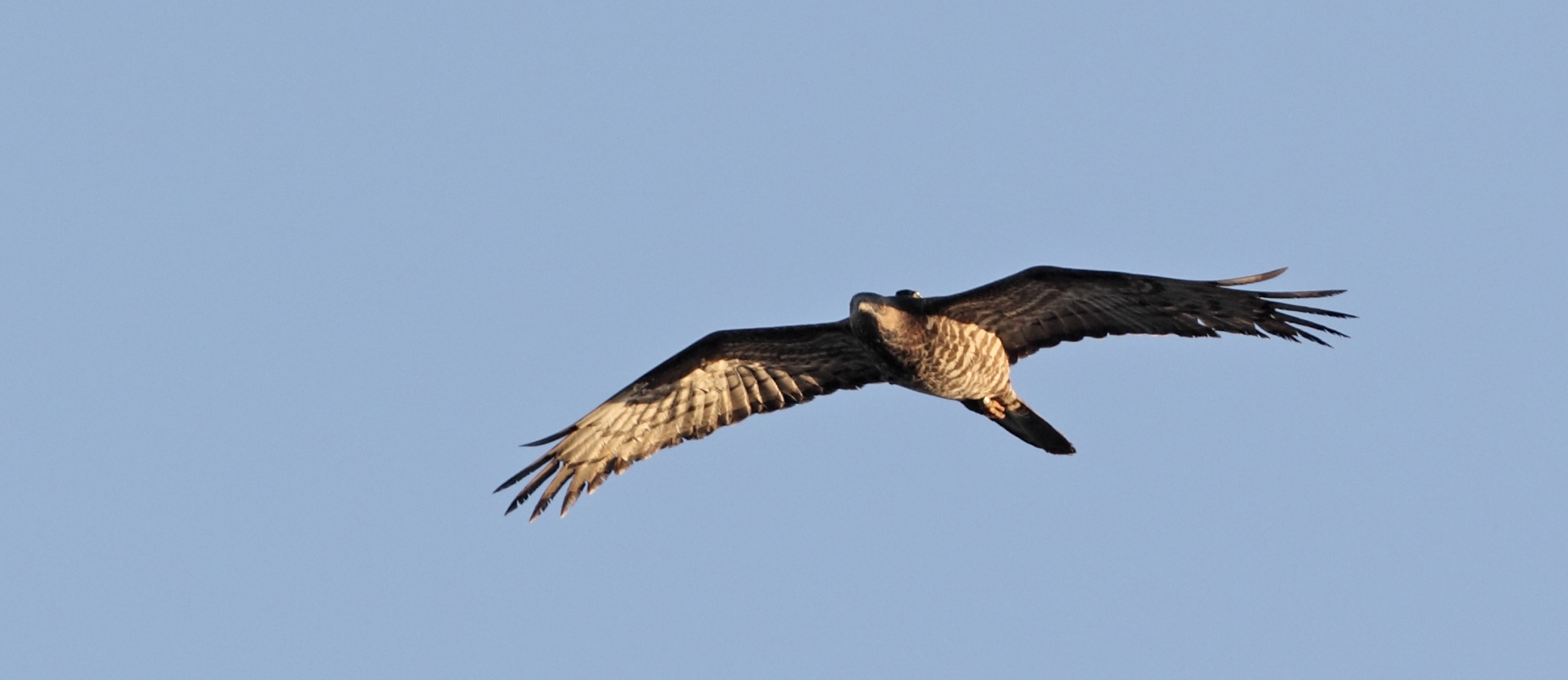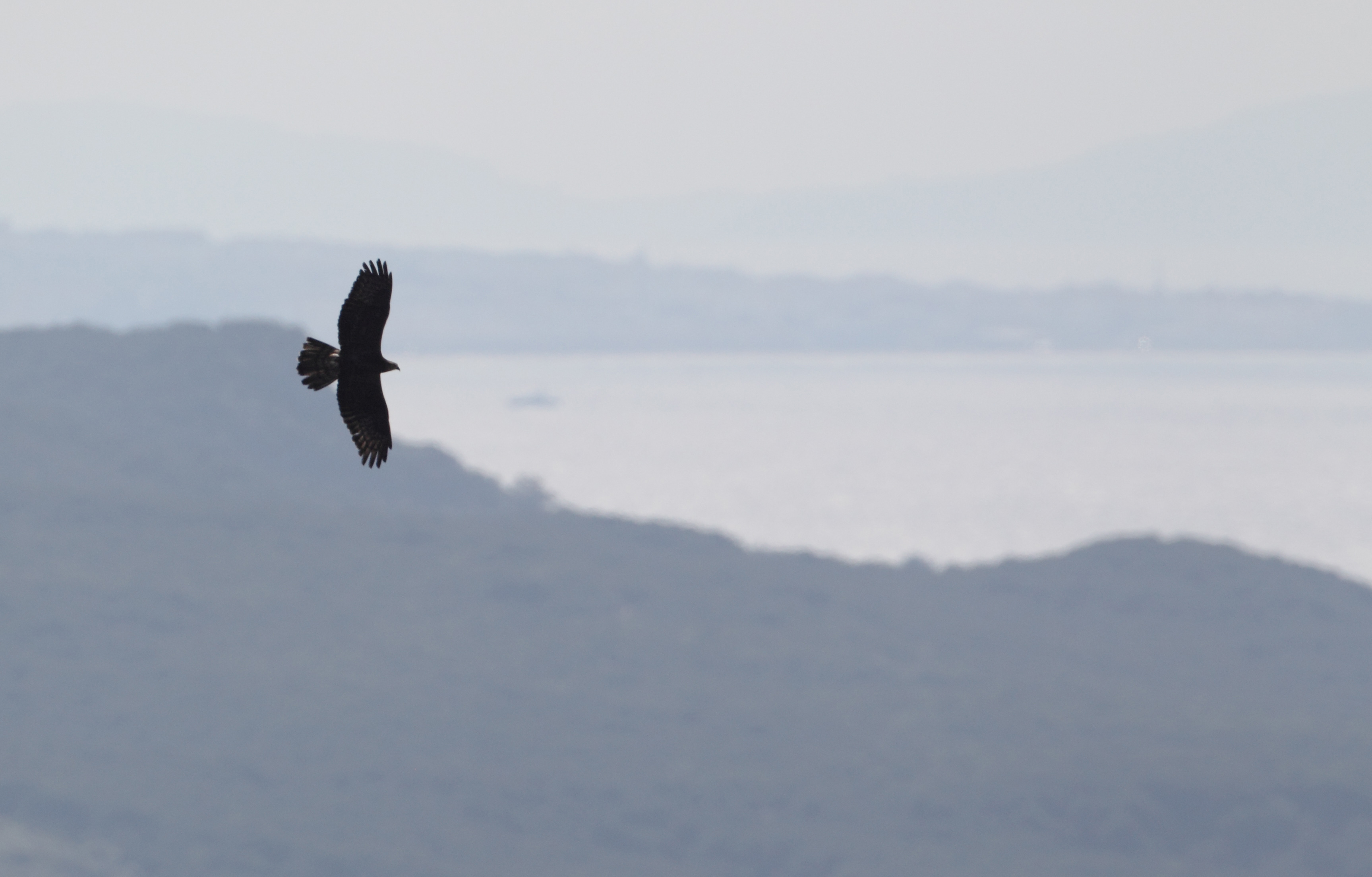Back in Europe: UvA-BiTS Honey Buzzard photographed at the Strait of Gibraltar
Wednesday, May 15th, 2013
Species: European Honey Buzzard
Project: Individual decision-rules of migrating Honey Buzzards
Spring is always an exciting time for UvA-BiTS researchers who study migratory birds as we need to wait for our birds to return from their wintering grounds before we can download our data from the GPS loggers. Until their return, we have no idea which birds are actually still alive. However, on May 7th 2013 an exciting email arrived at the CGE office in Amsterdam. Javier Eloriaga (Tarifa Birding Tours) reported that a male Honey Buzzard carrying an electronic tag had been observed at the Strait of Gibraltar on May 4th by Danish birder and photographer Helge Sørensen (www.birdphotos.dk). As the photographs came in it quickly became apparent that this individual was indeed one of our Dutch Honey Buzzards, making this the first confirmed observation of one of our buzzards outside the Netherlands.

Figure 1: UvA-BiTS Honey Buzzard male arriving in Europe at the Strait of Gibraltar around 8:30 PM on the evening of May 4th 2013 © Helge Sørensen
It seems very logical that this observation occurred at the Gibraltar Strait, as that is one of the main strategic goal-sites for Honey Buzzards migrating between western Europe and Africa. This is because crossing the Mediterranean only takes 14 kilometers there, which is a much safer route considering the risk of fatigue or encountering bad weather during longer sea crossings.

Figure 2: A picture can hardly capture the essence of raptor migration at the southern edge of Europe any better: leaving the Gibraltar Strait behind, this Honey Buzzard is stretching out her wings over Spanish land for the first time in 6 months © Helge Sørensen
In fact, all UvA-BiTS buzzards cross the Mediterranean basin at the Gibraltar Strait every season. However, if you consider that close to 100,000 Honey Buzzards make the crossing at Gibraltar each spring, it is remarkable that one of the currently 10-12 (providing they all survived) tagged Honey Buzzards (of which there are at least 6 with still active devices) was actually picked up there.

Figure 3: The migration from Europe into Africa and back becomes very concentrated near the Gibraltar Strait as demonstrated by these 49 migration tracks collected by 13 individual Honey Buzzards between autumn 2009 and spring 2012. Left and right showing autumn and spring respectively, tracks color coded per individual with symbols indicating years (diamond = 2009 triangle = 2010, square = 2011, cross = 2012). Point locations within each track resampled to hourly steps. Click on image to enlarge.
Based on Helge’s pictures we tentatively identified this bird as the male from a pair breeding in the Dutch forest ‘Drents-Friesche Wold’. Both birds of this pair were tagged for the first time last summer. We are very much looking forward to welcoming these birds back this year (so far 5 others have returned) and to confirm this individual is in fact the bird observed in Spain.
What is especially interesting about visual observations of tagged birds is that they provide useful data to verify (qualitatively) the measurements taken by the GPS device, and that they offer useful context in which to interpret the observed measurements. Luckily, Helge Sørensen is a keen observer who was able to provide a detailed description of his observation, and of the migration around May 4th:

Figure 4: It was 8:30 PM but still our male did not decide to hang around the beach for the night and disappeared with its comrades heading north. Just enough for one more nice shot of our bird in the evening sunlight© Helge Sørensen
“My friend and I stayed in the area of Tarifa between April 27th and May 5th in order to observe the raptor migration. During the first 3-4 days we had westerly winds and we saw very few raptors and only solitary Honey Buzzards. On May 1st – 2nd we had easterly winds but still didn’t see any noticeable migration, probably because we stayed on the east side of Tarifa. However, on (May 3rd) with easterly winds (4 m/s) we moved to the Bolonia area, and already at 9:23 in the morning we saw massive kettels of Honey Buzzards some 10 km inland of Bolonia. At noon we moved out to the coast and the birds were coming in good numbers, usually in groups of 10-30, flying low (20-80m) over the water surface. At around 2 pm we left the area, but came back around 7 PM. In the evening only few birds were coming in, and all of them rather low.
Due to that success on May 3rd we expected May 4th to be another great migration day. We started at the rocks above Bolonia beach at around 9 am. The first 100 or so birds were coming in over the next hour. Then, however, the migration stopped completely. The easterly wind was reaching a velocity of about 5m/s. Until noon, we only saw a handful of birds throughout the day. We were quite puzzled, and guessed that the birds had continued, but perhaps so high that we just couldn’t see them in binoculars or scope. At 7:30 PM few birds began coming in again, most of them arriving low over the sea surface, and gaining height after they met the rocks. We were standing on the first top of the rocks, thereby getting to see the birds at eye-level, or soaring through below us. Probably 100 birds came in until 8:40 pm when the migration stopped.
The UvA-BiTS Honey Buzzard was one in a group of 5-6 birds reaching the coast in active flight (first low over the sea, but we didn’t see him until he came around the ridge of the rock).”
We can only hope that this Honey Buzzard will successfully complete the rest of its journey without hindrance. Ultimately it would prove very interesting if more of these field observations can be collected in the future as these deliver very useful information which is not possible to collect with the GPS loggers. Such observations may lead us to study whether, for example, solitary birds fly differently than those in flocks. We strongly urge all birders out there to keep their eyes peeled for migrating Honey Buzzards (and other species) carrying transmission or logging devices and to record such observations with pictures, film or field notes in as much detail as possible.
Latest Highlights

Overwintering and foraging areas used by a 24-year old Eurasian spoonbill
Wednesday, April 18th, 2018

Lesser Black-backed Gulls from Schiermonnikoog enjoy their winter holiday
Tuesday, April 3rd, 2018

Oystercatchers returning from inland breeding grounds
Sunday, July 23rd, 2017

GPS tracker with SMS messaging
Monday, November 2nd, 2015

Ronny found back, three years after deployment of the UvA-BiTS GPS-tracker
Wednesday, July 8th, 2015

Lesser Black-backed Gulls feed on potato crisps in Moeskroen
Wednesday, November 13th, 2013

‘Vogel het uit!’ has won the 2013 Academic Year Prize
Tuesday, November 5th, 2013

Back in Europe: UvA-BiTS Honey Buzzard photographed at the Strait of Gibraltar
Wednesday, May 15th, 2013

UvA-BiTS database passes 10 million record mark
Wednesday, May 8th, 2013

Gulls pouring into the Kelderhuispolder colony
Wednesday, April 17th, 2013

To the Karoo and back: Mate replacement & GPS tracking study of an ousted eagle
Monday, March 25th, 2013

Meeting Montagu’s Harrier Edwin in Senegal
Wednesday, March 20th, 2013

Oystercatchers: Learning how and where to survive
Wednesday, August 29th, 2012

New GPS mini-tracker facilitates investigation into movement of smaller animals
Wednesday, July 4th, 2012

Over 5 million GPS fixes in the UvA-BiTS database
Thursday, June 21st, 2012

Tagged Lesser Black-backed Gulls return to Orford Ness
Wednesday, April 18th, 2012

Gulls spotted in their over-wintering areas
Wednesday, December 21st, 2011

The UK a top vacation destination in 2011
Wednesday, July 13th, 2011

A long way from home
Sunday, June 26th, 2011

Visiting Amsterdam for a day
Saturday, May 14th, 2011

Female deserts brood, male raises chicks
Friday, May 13th, 2011

Wintering range in Sierra Leone
Friday, May 13th, 2011

Camera watches foraging Oystercatchers day and night
Thursday, May 12th, 2011

The return of a bird presumed dead
Wednesday, May 11th, 2011

Texel gulls back from wintering areas
Sunday, May 1st, 2011

First Lesser Black-backed Gull returns to the breeding colony
Monday, April 13th, 2009

